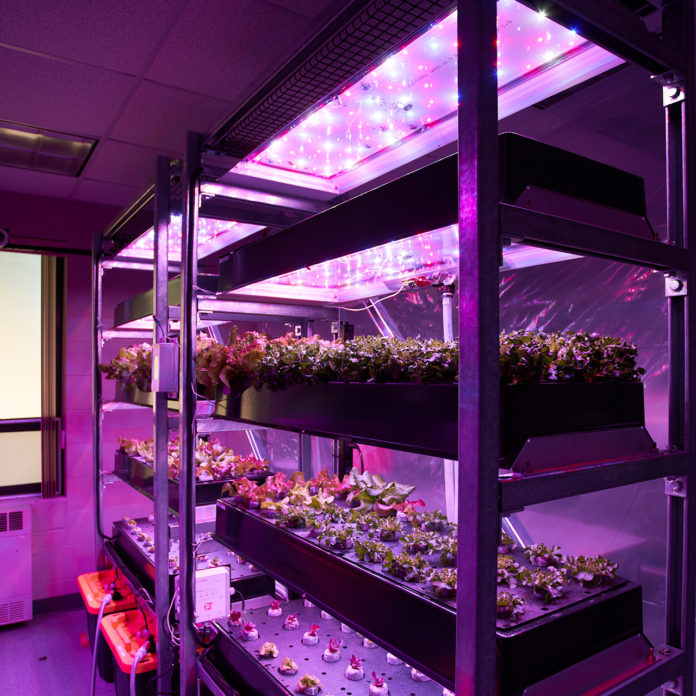UFV has partnered with QuantoTech Solutions Ltd. and i-Open Technologies Inc. to promote the development of vertical farming, a project that seeks to introduce sustainable agriculture to the rest of the world.
Alycia van der Gracht, the founder of QuantoTech Solutions, describes its development as a supplier of environment-friendly systems. “We started off as an LED lighting company initially. So we were making custom lights, and then we started adding on more high-powered lights, more control systems. And we always wanted to do food production. It stemmed from me trying to grow some of my plants outdoors when I went to the University of Lethbridge. Obviously, it gets quite cold over there in the wintertime, so the crops weren’t doing so good outside. I had to bring them in, and then I learned about LED lighting and growing indoors.”
Nandish Khandelwal, the horticulture supervisor at QuantoTech Solutions, responsible for farm marketing, describes his own experience with the project. “I’ve been working in the agriculture sector for quite some time. I did my studies at UFV in agriculture, and I’ve been working in research in agriculture before [QuantoTech] in the Fraser Valley, and then I got to know about it through UFV. I started working with them and that got me into the vertical farming sector.
“So basically, it’s growing plants in a vertical fashion instead of in the horizontal, and it allows you to use the space more efficiently so you can have almost 10 times the amount of plants in the same space by vertically staggering the shelves.
“We are stacking these growth shelves vertically on top of each other. Right? And hypothetically, you can go as far as maybe 10 levels or 20 levels, but right now we are doing four levels. In the future, we are willing to expand into multi-levels.”
As climate change leers around the world with its threats of heavy impact, Khandelwal explains the various ways vertical farming can combat this. “Let’s say about 80 to 90 per cent of the total phosphorus mined worldwide is used as fertilizer in agriculture.” Khandelwal states, “And if you will, that about 50 per cent of those fertilizers get wasted and are not taken up by plants. In vertical farming, we use all sorts of technology and all the latest inputs we have in technology and integrate them together to come up with the basic necessities that plants have.
“If you increase your fertilizer usage efficiency from 50 per cent to about 95 per cent, you have reduced the waste … Most importantly, nitrogen gets into the soil or flows to the water bodies and eventually lands in the ocean and leads to eutrophication. It would result in huge algae blooms, which are not good for the environment. So we can prevent those things from happening if we use the right amount of fertilizers, which vertical farming allows us to do while reducing the total amount of wastage.”
Going into food transportation and its environmental costs, Van der Gracht provides a sustainable solution. “Having to ship food is quite a big greenhouse gas emitter. So by being able to grow close to consumption, we’re able to also combat that.
“In vertical farming, companies aim to have continuous efficiency improvements and they try to introduce zero waste policies that help to reduce the carbon footprint. And the other thing is in conventional farming, you have to transport the produce grown from one state or one country to another one. And the longer the transport from retail to consumer, the higher the chance of contamination and food losses along the supply chain.”
Van der Gracht also goes into the implementation of vertical farming in society. “So for more remote locations, we’ll help them with our equipment, get that shipped out so that they could grow directly within their community. And then for bigger cities and more populated places like the Lower Mainland, we’re trying to decide between a couple of different models of either having a more centralized farm that’s larger, or a ton of little ones all over the place. So it might end up being some combination of the two, but because vertical farming and specifically our equipment is so scalable, it really gives us a lot of options.
“We want to use underutilized space. So we’re looking into the space between elevators and big developments that you can typically use for anything you can’t lease to people — because, I mean, who’s going to lease random space between elevators with no sunlight or anything like that? Also in parkades. A lot of people are working from home, so there’s more space available. So in a couple of the parking stalls, we could put a small micro farm there.
“Since our lights are very high intensity, we’re starting to look more into strawberries or cherry tomatoes, other herbs, and more automation with our equipment. We’re always trying to improve and reduce labour.”
As Khandelwal describes, the project has bigger visions across the world. “We can grow more diverse food products in this type of system, including growing crops, but with higher nutritional values like berries to provide the basic minimum calories to the people in developing countries who do not have access to food security.
“Vertical farming technology is definitely applicable in the areas that are called food deserts. I think the countries with temperate climates might not need them as much right now because they have the land and the climatic factors in their favour to grow these crops, but certainly in areas like our part of the world, where the climate is not productive.
“If we grow more crops in smaller spaces, then we can free up the land and let it be available for biodiversity instead of cutting trees down.”


